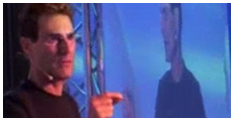Chapter 7
Movement of the surface of action
Once we have assumed the model of a surface of action, then an inference of its speed of movement follows from a measurement of the time between signals at two or more strain gauges at known locations. It is not necessarily a good assumption that the surface travels directly between two sensors at a uniform speed. Data are being collected in order to test this and similar assumptions. But if the assumption is valid, we have seen that it is possible to make the generalization that the speeds lie probably between 1 and 100 cm/sec.
The data show that there must be times when the motion of the surface is very slow. At a multiple strain gauge session with a sensor mounted on Stephen North’s forearm, speeds as low as 1 cm/see were frequently recorded. Therefore it should be possible for a strain pulse to be produced on a specimen which is physically impelled and moves through the surface. There have been several reports of cutlery being found to be bent after being thrown in the air; Andrew G. has reported throwing paperclips in the air and watching them land in the shape of treble clefs. A stroboscopic photograph of a spoon bending in flight has been published by Japanese researchers. Willie G. told me that he was able to bend metal in flight, but I soon found that it never happened when other people were present. It did not happen on video-camera either, so I arranged that Willie should be able to take his own stroboscopic flash photographs of swinging wires. Although he never succeeded in producing a photograph in which the metal specimen was straight in one flash and bent in the next, some of his photographs showed a bent specimen swinging from a thread, and bending more and more in consecutive flashes (ten per second). In one photograph the successive angles were 37.5°, 39.5° and 41.5°, in another 80°, 74°, 70.5° and 70°. What interfered with Willie’s efforts to achieve a better photograph was his apparent production (very possibly by paranormal means) of unwanted effects on photographic film. When he felt he had timed his ‘power’ to coincide perfectly with the camera shutter operation, he would find he had produced a Polaroid print covered with inexplicable images (see chapter 24). I believe it is likely that Willie did in fact cause metal specimens to bend in flight, but the experimental proof is not as watertight as could be wished.
Willie and his family of course knew nothing of my proposed ‘surface of action’, but they did form an opinion that the bending in flight could be affected by placing a heavy piece of metal on the floor. The specimen seemed to bend as it flew past it, although this was impossible to see with any certainty.
It is tempting to interpret these reports in terms of a surface of action stationary over the heavy piece of metal; as the specimen flies through the stationary surface, it receives a strain pulse and may well be deformed. Most of the specimens used in these attempts were lengths of 2 mm diameter tinned copper wire, very easily deformed.
Recent time-recorded dynamic strain recording experiments with Stephen North have demonstrated his action on a strain gauge embedded in a metal strip rocking to and fro on a moving wooden arm attached to a musical metronome. But the surface of action could not be kept motionless while the metal moved through it. The dynamic strain signals were recorded at all phases of the metronome motion.
Not only is the speed of motion of the surface of action important; one must also consider its possible change of shape whilst in motion. Many paranormal metal bends, particularly of easily deformed specimens such as wires, have been through very large angles, often several thousand degrees (spiral); occasionally the formation of the spiral is reported to take place in one continuous motion; it can be a little frightening to the child on the first occasion. In such an event we might imagine that the surface of action to some extent follows the form of the specimen; it is as though it clings to it, exerting continuous quasi-force. Such a clinging surface would be capable of forming remarkably complicated metal shapes, and these are precisely what have been found.
Plate 7.1 shows a ‘folded strip’ shape which several metal-benders have formed. Nicholas Williams was already familiar with violent spontaneous bending events when he and I first encountered a folded strip. One day I offered him pieces of very easily deformed aluminium alloy 30 cm X 8 mm X 0.75 mm, which he was able to leave on its own in anticipation of spontaneous action. We took them up to his third floor bedroom in the empty house, and placed them on a table, in the form of a cross. We both started to leave the room, without closing the door. Within seconds I heard a scratching noise, as though the metal strips were moving rapidly on the table. We found the strips folded together, and the free end of one of them twisted. The twisting gives a clue to a possible interpretation: namely that a surface of action starts to rotate about an axis in its own plane. The surface is caught between the two strips, and as it rotates it clings to them and causes them to form into folds. On this occasion one of the strips was longer than the other, and so one end was left free. By good fortune the axis of the rotating surface aligned itself along the free end, causing it to twist. This twisting has not been found in the many ‘folded strips’ which have since been made. Andrew G. and Willie G., albeit unobserved, both claim to have produced such folded strips without seeing the original, and without being told what might happen when two aluminium strips were crossed. A common feature is that a single coil is formed in the folded structure. More than two strips can be used, and more complicated folds obtained.
A number of folded strips were produced by Nicholas Williams without his being present in the bedroom. I did not destroy the delicate balance of observational psychology by installing a video-camera, but I recorded the speed of the events instrumentally in the following way. A magnetized tinned steel strip of very similar appearance was, unknown to Nicholas, substituted for one of the aluminium alloy strips; a fluxgate magnetometer probe was mounted near by on the table, but the nature of the experiment was not explained. When the folding took place, the time-varying magnetic field was chart-recorded, and showed rapid variations, as in Figure 7.1. Since the metal strips move around as they fold, one might expect there to be a simple proportionality between the number of chart-record peaks and the number of folds in the finished specimen; one, two or even three peaks per fold. The correspondence between the numbers of peaks and the numbers of folds is shown in Table 7.1; it encourages us to believe that the motion of the metal strips is being observed by this simple magnetic device. Similar experiments have been carried out with pairs of wires in a V configuration fixed by the apex to a wooden board.
The magnetic field variations, such as those shown in Figure 7.1, indicate that the rotation speeds of the surface of action can be as high as three revolutions per second. But we must beware of placing too much reliance on visually unobserved experiments.
| Designation | No. of folds or twists | No. of peaks in chart record | |
| Fold | M1 1 | 7 | 14 |
| M1 2 | 7 | 21 | |
| M1 3 | 12 | 48 | |
| M1 4 | 23 | 23 | |
| Twisted wire assembly | M2A 1 | 1 | 1 |
| 2 | 1 | 1 | |
| 3 | 1 | 1 | |
| 4 | 4 | 4 | |
| 5 | 4 | 8 | |
| Twisted wire assembly | M2C 1 | 2 1/2 | 5 |
| 2 | 4 | 8 | |
| 3 | 2 1/2 | 5 | |
| 4 | 4 | 8 |
A child who could rotate surfaces could, without touch, twist a single metal strip about its own axis; metal strips were exposed singly rather than in crossed pairs. An important question to be answered is how does the twisting depend upon the dimensions of the exposed specimen? It was answered by allowing Willie G., Andrew G. and Stephen North to twist aluminium strips of different widths, identical in other respects. The pitches were then measured, and analysed in terms of the torque G necessary to produce twisting, through an angle of a strip of cross-section dimensions a and b, and linear modulus of elasticity n. This torque is given by the equation:
G = n*pi*theta*(a^2 + b^2)ab/(12*l)
The dimensions of the metal strips were as follows: 10 <= l <= 40 cm, b = 0.75 mm, 1.5 <= a <= l3 mm.
Figure 7.1 Time-variation of magnetic field in the neighbourhood of folding of crossed strips of magnetized tinned steel and aluminium. Session M1, Nicholas Williams.
It follows that if pitch is proportional to a^2 + b^2, then the torque per unit strip width a is constant. The data displayed in Figure 7.2 show that this proportionality holds over more than an order of magnitude. Since the torque is force multiplied by strip width a, it follows that the quasi-force exerted by the surface of action is independent of the strip width. If the width were sufficiently small, these quasi-forces would be capable of doing serious damage to the metal; perhaps bringing about structural change. However, extrapolation through six orders of magnitude down to atomic dimensions would be too much of a liberty to take!
If the axis about which the surface of action rotates were not in the plane of the surface itself, strips of metal would not be twisted in the same way. If it were parallel to the surface but separated from it, as if the surface in rotation formed a tube, the strip would be bent into an Archimedean spiral. If it were inclined to the surface and passed through it, the strip would be formed into a helix. All these types of action have been found, but without leading the metal-bender towards a desired result. (The subject is discussed further in chapter 9.) Usually the supposed continuous rotation about a fixed axis does not continue for more than part of a single cycle. Non-uniform rotations and translational movements are the general rule. These result in the decorative shapes that some children, in particular Andrew G., claim to produce. They vary widely in size, from as large as 50 cm to as small as l mm. Andrew at one time must have achieved a considerable measure of control over his action so as to be able to produce the profusion of abstract and representational designs which have been seen by many people at a London exhibition and elsewhere (Plate 3.2). Julie Knowles has also exhibited art-work.
Difficulties about the conservation of angular momentum must be faced in interpreting these events. For a twisted strip to be produced by the quasi-force of a rotating surface, the strip must be held at one end, for example in the subject’s hand. But some subjects insist that this is not always the case, and that all sorts of twirled patterns can be formed on their own. Although this presents difficulties of credibility, I have come at length to believe that it could sometimes be so. The solid surface on which the event takes place, a table, carpet or bed, can contribute forces; and one must also consider the possibility that two surfaces of action, or at least two parts of the same surface, could exert opposing quasi-forces. It will be recalled that suspended metal specimens receiving strain gauge signals hardly swing on their suspension wires, even though quite large strains are involved. The strains arise from within the metal rather than from an external interaction.
It occurred to us that if a strip of metal can be twisted paranormally, when it is mounted on the axis of a miniature electric generator some rotation of the axle and its rotor might be observed. This would result in the generation of recordable electric signals. Willie G. did succeed in producing sporadic recorded pulses on such a device, without twisting his wrist, but distortion of the metal strip severely limited the success of the experiment.


Latest Articles

Motivational Inspirational Speaker
Motivational, inspirational, empowering compelling 'infotainment' which leaves the audience amazed, mesmerized, motivated, enthusiastic, revitalised and with a much improved positive mental attitude, state of mind & self-belief.



















